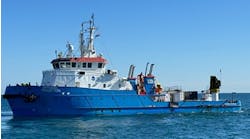Offshore staff
WASHINGTON, DC/ THE HAGUE, Netherlands -- A long-simmering maritime boundary dispute between Suriname and Guyana has recently been settled. The two South American countries' offshore waters are believed to contain significant oil and natural gas deposits.
Under terms of a tribunal's ruling announced Sept. 20, Guyana has been granted sovereignty over approximately 12,800 sq mi (33,152 sq km) of coastal waters that had been in dispute. Suriname was awarded 6,900 sq mi (17,871 sq km). This binding ruling, according to terms of the UN Convention of the Law of the Sea, is expected to lead to further offshore oil and gas exploration by both countries.
Among the parties awaiting resolution of the dispute were international oil and gas companies. The ruling ends a six-year standoff that began in June 2000 when the Suriname navy forcibly evicted personnel from an oil drilling rig, owned by Canada's CGX Energy Inc., a company Guyana had allowed within the disputed waters.
Guyana's lead counsel, Paul Reichler, a partner in the Washington office of law firm Foley Hoag LLP, says the ruling, which comes three and a half years after Guyana initially filed for arbitration, fortifies the role of international tribunals in adjudicating sovereignty disputes. According to Reichler, arbitrated settlements of international boundaries are rare occurrences, despite the large number of disputed maritime boundaries around the world.
"This is a hugely important win, not only in upholding Guyana's claims to its coastal waters, but in maintaining international law as a peaceful solution to resolving sovereign disputes," Reichler says. "The ruling could become an important model for settling other maritime delimitation conflicts, since the sad fact is that there are more disputed maritime claims around the world than there are settled maritime boundaries."
Guyana and Suriname have agreed to abide by the tribunal's ruling. Both nations now can proceed with exploration in their respective territories.
Guyana and Suriname are side-by-side on the northeastern coast of South America, between French Guiana and Venezuela. The exact position of the ocean boundary between them has long been a subject of disagreement.
Suriname had asserted a boundary further to the north and west, while Guyana had relied on the more widely accepted "equidistance line" method of determining the boundary, which placed it further to the south and east. The result was a cone-shaped area of uncertain sovereignty with its apex at the mouth of the Corentyne River, which separates the two nations.
International law regards the first 12 mi (19 km) of sea off a nation's coast as its sovereign territory, no different from land. The next 188 mi (302.5 km) are considered an Exclusive Economic Zone, wherein the coastal nation enjoys sole rights to all ocean resources, although vessels from other nations may pass through.
9/21/2007


